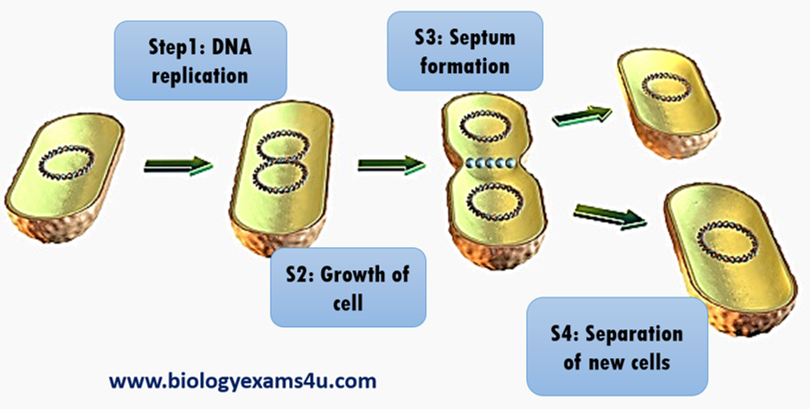Binary fission (“division into two”)
Definition: A common type of asexual reproduction in prokaryotes like
bacteria, where a parent cell divides to form two identical cells and each having
the potential to grow to the size of of the original cell.
Why is Binary fission asexual?
In binary fission, one bacterial cell splits into two. There
is no sexual fusion of gametes or involvement of gametes.
Which are the steps in binary fission?
Step 1: DNA replication
In Prokaryotes DNA is circular. Replication begins at origin
of replication or ori and continues in both directions. At first, ftsZ protein
is dispersed in the cytoplasm.
What is FtsZ protein?
FtsZ is a protein encoded by the ftsZ (filamenting
temperature sensitive mutant Z) gene that regulates
septum formation in binary fission of prokaryotes.
Step 2: Growth of Cell or cell elongation
The cells grow in size or doubles in size and ftsZ protein
migrates towards the midpoint.
Duplicated circular DNA moves to the opposite poles of the
growing cell.
Step 3: Septum formation or Cross wall formation
ftsZ protein moves towards the center and forms a ring which
is called as ftsZ ring or Z ring.
What is the role of Z ring in binary fission?
FtsZ ring is to recruit other cell division proteins to the
septum to produce a new cell wall between the dividing cells or Z ring directs
the formation of septum that divides the cell.
Plasma membrane and other cell wall materials will be
deposited to form the septum.
Step 4: Separation of daughter cells
When septum formation is complete, the cell pinches in two, forming
two daughter cells. FtsZ protein once again gets dispersed in the cytoplasm of
new cells.
Bacterial cytokinesis is mediated by the Z ring, a cytoskeletal element formed by the polymerization of FtsZ protein. This is homologous to tubulin, the cytoskelotal element that forms the microtubules in eukaryotes. Despite billions of years of bacterial evolution, the Z ring is nearly universal among bacteria that have a cell wall and divide by binary fission.
Reference:
Du, S., & Lutkenhaus, J. (2019). At the Heart of Bacterial Cytokinesis: The Z Ring. Trends in microbiology, 27(9), 781–791. https://doi.org/10.1016/j.tim.2019.04.011
Binary Fission. https://bio.libretexts.org/@go/page/9177


